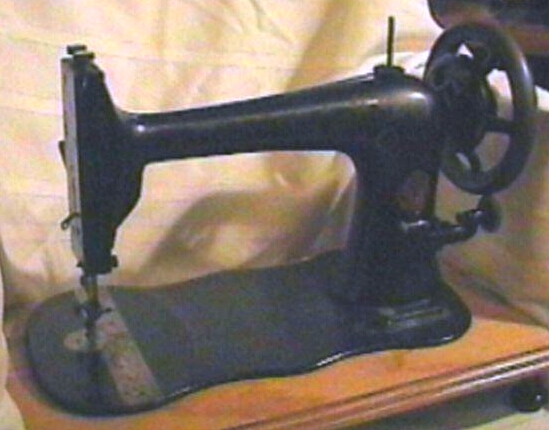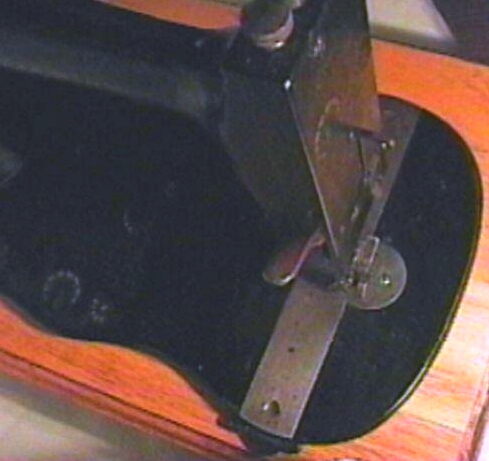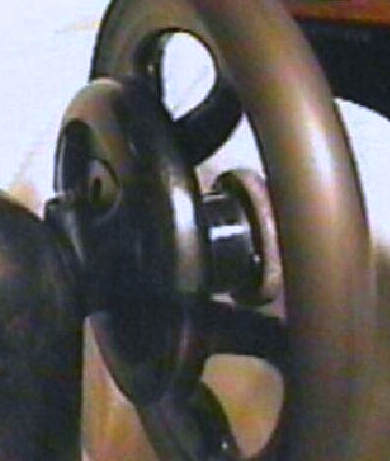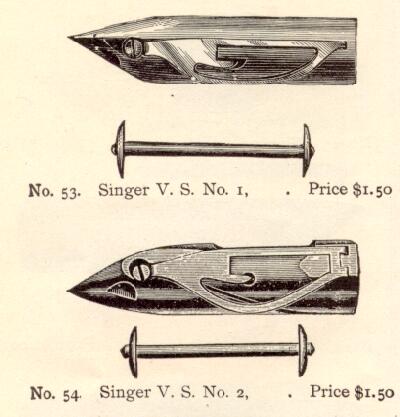Singer's Missing Link, the Legendary Vibrating Shuttle #1

Early in my experience as a sewing machine collector, I purchased a Singer sewing machine head with a patent date in 1885. I had assumed from the sewing mechanism and the shape -- the high arm and the fiddlebed -- that this machine was an example of the famous Vibrating Shuttle #2. After I cleaned it up, however, I began to notice some significant differences, and when I called Singer, they told me it was listed in their records as a "High Arm".
Singer came out with four main models in the 1880s which had a high arm. Each used a different sewing mechanism: oscillating shuttle, vibrating shuttle, transverse shuttle, and chain stitch. This was the vibrating shuttle version.
As I studied my machine, it occurred to me that the machine was more primitive than the V.S. #2, yet more sophisticated than the company's previous model, the New Family Model 12. It became readily apparent that this "new" machine had some features in common with both of the others. Certain features harken back to the New Family, while others predict the V.S. #2.
I compiled a list of features and noted how these were implemented on each machine:
A comparison of Features of Singer's Shuttle Sewing Machines in the 1880s:
|
Late 1880s
Singer Vibrating Shuttle #2 |
Mid-1880s
Singer V.S. #1 |
Early 1880s
Singer New Family |
|---|---|---|
|
Plated faceplate |
Painted facebox |
Painted facebox |
|
Stitch control on pillar |
Stitch control in slot on bed |
Stitch control in slot on bed |
|
Tension on front left end of arm |
Tension on lower front of facebox |
Tension on lower front of facebox |
|
Tension adjustment screw on front of left end of arm |
Tension adjustment screw on top of facebox |
Tension adjustment screw on top of facebox |
|
Oiling plate and large hole on left end of arm |
Small oiling hole on left end of arm |
Small oiling hole on left end of arm |
|
Bobbin winder with thread guide |
Bobbin winder without thread guide |
Bobbin winder without thread guide |
|
Bobbin winder powered by contact with belt |
Bobbin winder powered by contact with wheel |
Bobbin winder powered by contact with wheel |
|
Bobbin winder on pillar |
Bobbin winder on pillar |
Bobbin winder on bed |
|
Front and back bedslides |
Front and back bedslides |
Left and right bedslides |
|
Circular throatplate |
Circular throatplate |
Rectangular throatplate |
|
Small balance wheel in proportion to machine |
Small balance wheel in proportion to machine |
Large balance wheel in proportion to machine |
|
Top-only treadle belt cover |
Top-only treadle belt cover |
Full-length treadle belt cover |
|
High arm |
High arm |
Low arm |
These features can be seen in the pictures below:




The V.S. #1's bedslides are decidedly wider than those of the V.S. #2. And the V.S. #1 uses a bobbin which is different from both the New Family and the Vibrating Shuttle #2. The carriage is identical to that on the V.S. #2, so the V.S. #1's shuttle is the same length. The three types are shown below in the same order as in the chart:

The New Family boat shuttle is shown above on the right with its bobbin. The V.S. #1 shuttle and bobbin are in the middle, and the V.S. #2 shuttle and bobbin are on the left.
The New Family shuttle is open on the side and shorter than the other two. Its bobbin has pointed ends which fit firmly into depressions in the shuttle. The V.S. #2 and V.S. #1 shuttles are cylinders which are open on one end and pointed on the other. The bobbin is placed loosely in the shuttle. The V.S. #2 and V.S. #1 shuttles are the same length, but the V.S. #1 bobbin is a tad longer, and that tad is just enough to keep me from being able to use a V.S. #2 bobbin in the V.S. #1's bobbin winder. The bobbin that came with my V.S. #1 is the only bobbin in the house that fits its bobbin winder! Note that the tension spring on the V.S. #1's shuttle is a bit different from the V.S. #2's also. The V.S. #2's shuttle has an indentation on its belly (like it's trying to suck it in to look good or something), whereas the V.S. #1's belly is straight the entire way down. Both have a dimple at the pointed end to anchor them in the shuttle race when placed in the machine.
As the chart and pictures show, there are numerous similarities between the V.S. #1 and Singer's other family machines from the same decade. There are also differences. It is as though the V.S. #1 is half-New Family and half-V.S. #2. The V.S. #1 clearly is a transitional machine. Even its shuttle is transitional! This comparison intrigued me all the more, so I began to collect documentary evidence.
A Singer booklet entitled Mechanics of the Sewing Machine (1914) has this to say about the early Singer vibrating shuttle machines:
The vibrating shuttle (V.S. No. 1) for foot power was patented in 1885 but was superceded by the V.S. No. 2 in 1887, which has been in vogue ever since, and millions of these machines are now in family use all over the world.
The last patent date on the V.S. #1 is 09 June 1885, the same year Singer's V.S. #1 was patented. The earliest V.S. #2s date to 1887, just as the quotation suggests. Moreover, the both the High Arm and V.S. #1 are virtually unknown today. During my research I've encountered only two other collectors with an example of this machine (both have the machine in its original cabinet). That suggests that very few of these machines were made, that they were made for only a very short time. That fact gibes very well with Singer's quotation, as the V.S. #2 is said to have "superceded" the V.S. #1 after only two years of production.
By comparison with the V.S. #1 and the High Arm, the Vibrating Shuttle #2 was everywhere by the turn of the century, and many are still available today. As the Singer booklet records, there were indeed millions sold. Now, why would Singer and the rest of us refer to that machine as the "V.S. #2" if there had never been a "V.S. #1"? There must have been a predecessor which shared the V.S. #2's vibrating shuttle mechanism -- as the my machine does.
And then I came into possession of a V.S. #2 manual dated in 1888, just one year after the V.S. #2 patent date provided in Singer's history quoted above. The manual calls the model "The Singer Mfg. Co.'s Vibrating Shuttle No. 2 Sewing Machine":

It's a bit hard to see the "No. 2"; it's in white lettering just above the "M" in "Machine".
The name clearly indicates that there was once a V.S. #1.
Now here's something interesting: the shuttle depicted in the book is the V.S. #1's relatively straight-sided shuttle -- and the tension spring has more in common with the V.S. #1's tension spring than with the more typical V.S. #2 shuttle I've pictured in the comparison photo above!

It's apparent that, even in 1888, Singer wasn't quite finished with the improvements of its new improved V.S. #1/V.S. #2!
A 1917 trade catalog shows the following listings of shuttles:

Note that the "Singer V.S. No. 1" shuttle is identical! And the bobbin is just a tad longer than the V.S. No. 2 bobbin shown, just like the my machine's bobbin.
Combined, this evidence demonstrates that this is the first example of a Singer vibrating shuttle machine for family use, the "V.S. No. 1" mentioned in Singer's Mechanics of the Sewing Machine (1914). The short-lived V.S. #1 was Singer's first attempt in a series of vibrating shuttle machines, which were refined and improved over the next decades as the V.S. #2, class 27, and 127. Like the oscillating shuttle and chain-stitch machines of the 1880s, the high arm V.S. #1 represents a radical departure for the company from the low-arm machine that made "Singer" a household word, the New Family Model 12, but it still shares many of its predecessor's characteristics.






